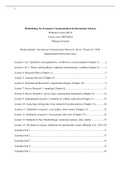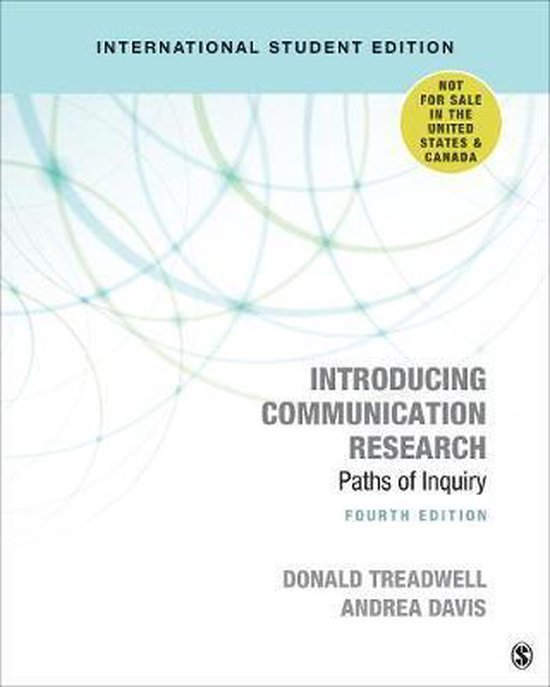1
Methodology for Premaster Communication & Information Sciences
Premaster course (2021)
Course code: 800550-B-6
Tilburg University
Book summary: Introducing Communication Research. 4th ed. (Treadwell, 2020)
Supplemented with lecture notes.
Lectures 1 & 2: Qualitative and quantitative, worldviews, research purpose (Chapter 1).........2
Lectures 2 & 3: Theory and hypotheses, induction and deduction, variables (Chapter 2).........3
Lecture 4: Research Ethics (Chapter 3)......................................................................................5
Lecture 5: Literature Review (Chapter 4)...................................................................................7
Lecture 6: Experimental Research I: experimental designs (Chapter 10)...................................9
Lecture 7: Survey Research 1: sampling (Chapter 6)...............................................................11
Lecture 8: Survey research 2: survey types, measurement instruments (Chapter 9)................14
Lecture 9: Experimental research 2: reliability & validity, replication (Chapter 5).................18
Lecture 10: Analyzing existing data: from content to big data analysis (Chapter 11)..............20
Lectures 11: Qualitative research 1: case studies, observations (Chapter 13)..........................22
Lecture 12: Qualitative research 2: focus groups, interviews (Chapter 13)..............................26
Lecture 13: Methods for New Media Design: contextual analysis, diary studies.....................27
Lecture 14: The future of science. Manifesto for reproducible science (Munafo et al., 2017).29
Learning Goal 1........................................................................................................................31
Learning Goal 2........................................................................................................................33
Learning Goal 3........................................................................................................................34
Learning Goal 4........................................................................................................................35
Learning Goal 5........................................................................................................................36
,2
Lectures 1 & 2: Qualitative and quantitative, worldviews, research purpose (Chapter 1)
Any research project requires that you start by getting yourself oriented toward an area of
interest. Every research question has assumptions behind it that reflect the researchers' view
of communication and how to study it.
Ontology: how to define communication.
Epistomoly: philosophy of your beliefs, in this topic: how to define communication.
Each researcher has his own ontology and epistemology.
Several major assumptions are:
Observation capture or does not capture an underlying reality
Theories about human behavior can or cannot be generalized
Researchers should or should not distance themselves from their research participants
Research should or should not be done for a specific purpose
There is or there is not one best position from which to observe human behavior
Because it is almost impossible to examine and explain a communication event in its totality,
researchers focus on a part of that totality and choose a method for investigating in which they
have a comfort level (methodological or ideological). Therefore, we make choices that are
almost inevitable for all types of researchers: unavoidable decisions
Your field of study: wide or narrow?
The researcher: are you dispassionate or involved?
The approach: objective of subjective?
The perspective: your questions or their answers?
The sample: large or small?
The data: quantitative or qualitative? Researchers may use qualitative (words)
methods, quantitative (numbers) methods or both (triangulation).
o Qualitative: interviews, focus groups, case studies, observational studies. In
this study, researchers are generally interested in experiences. The researcher
does not directly ask for advantages/influences (no direct questions but subtle
questions instead, do not ask the RQ!). Asking questions is not enough to call
the study design an interview, in surveys for example you also ask questions.
Research that usually is interested in experiences (inducing peoples meaning).
o Quantitative: experiments, surveys, content analysis, meta analysis,
computational analysis. Research that usually is interested in effects.
,3
Triangulation: Few of the above “either-or” (qualitative or quantitative) distinctions are clear-
cut. In practice, many of the seeming opposites blend together. The most obvious blending is
in the approach called triangulation in which researchers use multiple methods providing
multiple perspectives to ensure that they have a good “fix” on a problem. The use of two or
more research methods to address the same research question. If results from different
methods agree, researchers can have greater confidence in their findings.
The report: subjective or objective?
Lectures 2 & 3: Theory and hypotheses, induction and deduction, variables (Chapter 2)
Credible research has a logical link between the method chosen and the assumptions that
underpin them. The research method you select should follow logically from your basic
assumptions about human behavior and communication.
1) Basic assumptions that underpin your research
Basic assumptions about human behavior coalesce into broad worldviews or basic sets of
beliefs that underpin our perspectives on communication research.
Worldview I (nomothetic): human behavior is predictable, objectively measurable and
generalizable. Privileges researchers perspective.
Worldview II (ideographic): sees human behavior as individualistic, unpredictable, and
subjective. Privileges participants perspectives.
More nuanced views are: Postpositive, Constructivist, Transformative, Pragmatism
A theory about communication is weak if not supported by evidence so as a researcher you
move between theory and observation. Three thought processes that link observation with
theories are
- Induction: reasoning from observation (particular) to a theory that might
explain your observations (general); > theory building / hypotheses
generation/ exploration (not logically valid)
- Deduction: moving from a theory (general) to defining the observations
(particular) you will make > theory / hypotheses testing (logically valid)
- Abduction: reasoning from an effect to possible causes. Narrowing down to
the best option. (similar to induction > not logically valid)
2) Starting with a focus
, 4
Research Questions: open-endend (is there a relationship between variables) or closed-ended
research questions (focus on direct relationships).
A good theory can be falsified, you need to be able to test the theory. A good theory generates
hypotheses (that are testable). Also, it covers a broad area. It is substantiated by a lot of
evidence (multiple studies pointing in the same direction).
Hypotheses: statements about relationships we expect to find. It is not about true or false but
about support to a certain extent.
- One-tailed hypotheses (prediction on direction of relationship between variables)
- Two-tailed hypotheses (there is a relationship, but it is not specified)
- Null hypotheses (specifies that there is no relationship).
Variables: dependent (outcome) & independent (manipulated in experimental research > e.g.
2 or 3 levels). Research can contain more than one independent variable, this is different from
a IV with multiple levels. There can be two or more IV in the study in general. Also, control
variables are independent variables. IV vary!
- Moderating variables: how you are as a person (personal), can influence the
dependent variable. Often, this variable is also measured. The amount of an effect
of IV on DV may depend on a moderating variable (which is often not
manipulated).
A moderator does not have to be related to the IV and/or DV. It affects the relationship
between IV & DV, so it affects what happens in between these two variables.
- Interacting variables: variable you use to manipulate/help the other IV. Sometimes
the effect of one IV on the DV depends on the level of the other IV. If you cannot
state what the effect of one IV is without mentioning the other IV, there is an
interaction effect (e.g. profile picture + text errors)
- Mediation variables: When there is mediation, the effect of IV on DV is indirect.
The IV influences the mediating variable, which in turn has an effect ont he DV.
Mediation may be partial or full. (IV: error > MedV > intelligence > DV:
attractiveness).
Mediators transmit the effect of an IV to a DV. So, the IV is there first > it affects the
MedV > which affects the DV.






